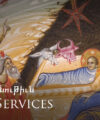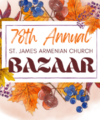The Armenian Church: A Brief Introduction
The Church was founded by Jesus Christ. According to tradition, two of His Apostles ― St. Thaddeus and St. Bartholomew ― preached His Gospel in Armenia as early as the second half of the first century. Then in the early fourth century St. Gregory the Illuminator formally established the Church in Armenia, when King Tiridates III was baptized and declared Christianity as the state religion. St. Gregory (c. 240-325 AD) was a descendant of a noble house in Parthia, who was brought up as a Christian in Cappadocia. He was consecrated a bishop by Leontius, the metropolitan of Caesarea, as the first Bishop of Armenia. He began his missionary work in Armenia during the first decade of the fourth century, while a layman ― and upon is consecration as Bishop ― he established the Armenian nation’s Holy See in Vagharshapat (Etchmiadzin). He is called Illuminator for “enlightening the nation with the light of the gospel” through baptism. Etchmiadzin, literally, means “the only begotten descended.” According to tradition, St. Gregory saw Christ in a vision, who indicated to him where to build His Church, the first Armenian Church.
Indeed, the Christianization of Armenia “determined the entire future course of Armenian history”. As the new Faith took roots in the life of the nation, the invention of an Armenian alphabet was necessitated. Realizing the needs of the Armenian faithful, in 406, St. Mesrob Mashdotz created the Armenian alphabet, under the auspices of Catholicos Sahag, in order to make the Christian faith accessible to the people in a written form. Greek and Syriac were the languages used in the church services.
Soon after the invention of the alphabet, St. Mesrob together with St. Sahag and a group of associates ― known as Holy Translators ― translated the Holy Scriptures into Armenian, followed by the biblical, theological and liturgical writings of eminent church fathers. This most important era is known as the Golden Age of Armenian history. “The missionary and literary labors [of this period] shaped the destiny of the Armenian people and Church for succeeding generations. [St. Mesrob and St. Sahag, their disciples and co-workers] spearheaded the creation of the Armenian Christian culture under the patronage of the King Vramshapuh. This period was one of intense activity and rapid development for the Church and was decisive in its consolidation and nationalization”.
One of the most significant events in Armenian Christianity is the battle of Avarair. Toward the middle of the fifth century, Armenia faced growing pressures from the Persian King Yazdegert II, who had issued an edict bidding the Armenians to renounce Christ and embrace Zoroastrianism. In 451, headed by the commander-in-chief Vartan Mamikonian, Armenians fought against the Persians to preserve their faith. Yeghishe, the historian who wrote The History of Vartan and the Armenian War, in a dialogue between the Persian Tenshabuh (ambassador) and the Priest Ghevont, expresses the profundity of this faith: “Christ, the living and life-giving true God, by His beneficent will became the healer of souls and bodies and Himself first suffered tortures and pains to cure the entire human race. He granted us second birth in health without pains and afflictions”. St. Vartan fell in the battlefield of Avarair and Armenians were physically defeated. For the next thirty years, Persian oppression followed and Armenian resistance under the leadership of Vahan Mamikonian (Vartan’s nephew) continued until 484, when the Persian King Peroz reversed course and declared full toleration of Christian faith and the formal recognition of the Church in the treaty of Navarsak.
The following centuries were difficult periods in Armenian history, starting with Persian rule (430-634) and later Arab domination (c. 654-851). In the 9th century (c. 885) there was an independent kingdom of the Bagratids in Armenia, however it ended in 1079. In the medieval Kingdom of Cilicia, or Lesser Armenia, there was an independent entity from the end of the 12th century to 1375. Persecution and martyrdom had become common occurrences. A larger proportion of Armenians were massacred in the Ottoman Empire starting in the late 19th century to the Genocide in the early 20th century. Armenians also suffered under the Russians starting in 1893 and later in the Soviet Union until the 1980s.
In assessing history and the role of the Armenian Church in the life of the Armenian nation, Archbishop Aram Keshishian (Catholicos of Cilicia since 1995) writes: “Confessing Christ has become the quintessence of our history. The history of the Armenian Church in all its manifestations and achievements, conflicts and struggles, is in the fullest sense of the term the history of confessing Christ in action. All the spheres of our life were touched by the transforming power of Christ. The Armenian culture in particular with its spiritual depth and transcendent dynamism has provided the Church with creative insights and new perspectives and horizons in terms of integrating Christ into the ethos of the Nation” .
The Faith of the Armenian Church
The Faith of the Armenian Church is transmitted through the church’s Holy Tradition, that is, the ongoing life of the church from the time of Christ to our times. The Bible, liturgy and worship, writings of the church fathers, church councils, saints, canons, religious art and rituals ― organically linked together ― formulate the Holy Tradition of the Church. This Faith is articulated in the Creed of the Armenian Church, the formal declaration of beliefs, which in turn defines the church’s raison d’etre and sets the parameters of its mission and functioning.
The Armenian Church professes her faith in the context of her worship. Theologically, whatever the church believes, the church prays. As such, the Armenian Church’s worship and liturgy constitute a prime source for teaching and living her faith. Tradition, on the other hand, defines and formulates the “articles of faith” and transmits them from generation to generation.
As articulated in the Creed, the Armenian Church believes in One God, the Father Almighty who is the Creator of heaven and earth, of all things visible and invisible. Humanity (male and female) is created in the image and likeness of God, and as such is a special creature. However, because of the Fall of man, sin entered the world.
The Church believes in Jesus Christ, “the only begotten Son of God, who came down from heaven, was incarnate, was born of the Virgin Mary, by the Holy Spirit.” He became man, suffered and was crucified, and was buried. He rose again from the dead on the third day and ascended into heaven and sits at the right hand of the Father. He will come again with glory to judge the living and the dead.
The Armenian Church believes in the Holy Spirit, uncreated and perfect, who proceeds from the Father, and together with the Father and the Son is worshipped and glorified. The Holy Spirit spoke to the prophets and apostles and descended into the Jordan river, witnessing Christ’s Baptism.
The Armenian Church is One, Holy, Apostolic, Catholic Church. She believes in one Baptism with repentance for the remission and forgiveness of sins. On judgment day, Christ will call all men and women who have repented to eternal life in His Heavenly Kingdom, which has no end. Christ overcame the power of death with His own death and gave salvation to all mankind. The dogmas of the Armenian Church are based on these “articles of faith.”
Family of Churches
The Armenian Church belongs to the Orthodox family of churches, known as the Oriental Orthodox, or Non-Chalcedonian, Churches: the Armenian, Coptic, Syrian, Indian Malabar, Ethiopian and Eritrean churches.
Generally, Christianity is divided mainly between Eastern and Western churches. The relationship between Byzantium (East) and Rome (West) deteriorated gradually. In the ninth century a schism between the Byzantine Church and the Church of Rome started to shape during the time of Patriarch Photius. In 1054, anathemas were declared by both sides (Patriarch Michael and Cardinal Humbert), which lasted for centuries. By 1204, when the Crusaders captured Constantinople, the schism had become final. In 1965, following the Vatican II Council, the anathemas were lifted by both sides in a spirit of ecumenism and understanding among the churches.
The main theological differences and disagreements between the Eastern (including the Armenians) and the Church of Rome (Catholics) are in the following issues:
Papal Supremacy: the Roman Catholics consider the Pope the “Vicar of Christ”, while the Orthodox churches consider him only as “first in honor” and in pastoral diakonia.
Papal Infallibility: The Catholics follow a “monarchical” model of ecclesial polity, whereby pronouncements of the Pope made on behalf of the Church (ex cathedra) are considered infallible. The Orthodox follow a “conciliar” model, where church councils determine church dogma, canons and policies.
There are also other minor differences between these two branches of churches, for example, regarding the rules of fasting; unleavened bread at Eucharist (West); manner of conferring confirmation; celibacy of clergy; divorce (not sanctioned in Roman Catholicism); purgatory (East doesn’t teach it); West has “scholastic’ approach, East has “mystical” approach to theological issues.
On the other hand, the main difference between the Byzantine tradition (Eastern Orthodox) ― also known as Chalcedonian churches ― and the Armenian Church (along with the Oriental Orthodox Churches) has been on the issue of Christology, namely, regarding the dogma on Christ’s Divine and Human natures. The controversy originated at the Council of Chalcedon in 451, which defined Christ as “Perfect God and Perfect Man in One Person” and “confessed to be in two natures, without mixture and without change, without separation and without division…”.
Unlike the formulation at Chalcedon, the Armenian Church’s Christology is based on what is known as the Alexandrian school of theology. St. Cyril of Alexnadria’s formula of ‘One Nature of the Incarnate Word’ is the basis of this Christology. It teaches that at the moment of Christ’s Incarnation, divine nature and human nature are united inseparably in a single nature, that is, ‘in a single person’. Catholicos Karekin I explains: “The two natures haven’t lost their own characteristics or their integrity, but they do not act separately; otherwise, we would have a dualism, and the Incarnation would not have taken place”. Furthermore, “‘One Nature’ is never interpreted in the Armenian Christology as a numerical one, but always a united one,” adds Abp. Keshishian. “Second, the term ‘nature’ (Greek ousia, Armenian bnut’iun) is used in Armenian theological literature in three different senses: (a) as essence, an abstract notion, (b) as substance, a concrete reality, (c) as person. In the context of anti-Chalcedonian Christology ‘one nature’ is used in a sense of ‘one person’ composed of two natures”.
The followers of Cyril of Alexandria and those who adopted his formulation became known as monophysites (those advocating ‘one nature’) because they rejected the formulation of Chalcedon on the basis that the Council spoke of two natures (Diophysites). This is why the Armenian and the other Oriental Churches are also known as Non-Chalcedonian Churches and are sometimes erroneously referred to as Monophysite Churches.
These Christological terminology and debates might seem trivial to the laymen, but the theological controvery continued for centuries, often becoming a matter of political influence and expediency. But, in 1990, the theologians and official representatives of both Eastern (Byzantine) and Oriental Orthodox Churches ― after years of dialogue and consultations ― agreed in a formal statement that their theological understanding, especially their Christology, is “orthodox.” The statement called for unity and communion between the two branches of Orthodox Churches. The document was sent to the respective leaders of the participating churches for review and formal approval.
-Hratch Tchilingirian



